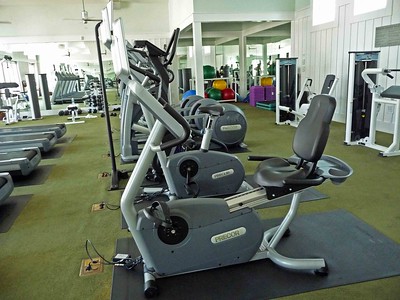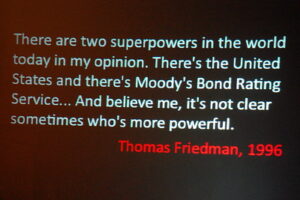I ran across some interesting statistics regarding fitness center operation recently. The figures are important, because they raise serious questions about the long-term viability of the WCC Fitness Center.
WCC states that the Health and Fitness Center returned $1,750,000 in the last pre-pandemic year. Unfortunately, it’s not enough to look at numbers in isolation. There are some industry standard ways to measure the financial performance of a fitness center.
Fitness Center revenue per member
According to RunRepeat, using information provided by the 16 largest fitness center providers in the US, the average cost of a fitness center membership for high-end fitness centers was about $45 per month. WCC Fitness Center users report that their membership costs are closer to $65-$70 per month.
The first comparison we can make is revenue per member. Based on pre-pandemic usage information provided by the CFO, we can say that there were about HFC 7,500 members. If every member paid full price, the HFC would generate about $5.85M in gross revenue, or about $780 per member. Its gross revenue figure is smaller, however, because not all members pay full price for their memberships. WCC records HFC revenue of $1,750,000 per year. Divided by 7,500, the HFC generates revenue of $233 per member. That’s less than 30% of the facility’s gross revenue.
WCC’s $1,750,000 isn’t profit, though. From that money, the college has to pay the loan debt, perform repairs and rehab on the facility, replace equipment, etc. The bond payment on the building from now until 2027 will exceed $1M per year.
Revenue per square foot
The Health and Fitness Center at WCC is a 76,831-square foot building. Comparing the revenue to the facility’s square footage effectively provides a measure of the efficiency of revenue generation. In WCC’s case, the College reaped (in 2019) $22.78 per square foot. Industry average for facilities larger than 5,000 square feet is $76 per square foot. If every HFC member paid full price for their memberships, the HFC would meet this standard, however, a large percentage of members do not pay the rack rate for membership.
In other words, the HFC does not generate revenue as efficiently as other large fitness center facilities do. This is also a problem, since the HFC is supposed to pay for itself. Inefficient revenue generation could mean the HFC is leaving money on the table. It could also mean that the HFC cannot – for whatever reason -generate revenue as efficiently as other comparable facilities. Either way, the Washtenaw County taxpayer loses.
COVID pause
In March 2020, Michigan’s governor ordered health and fitness centers around the state to close. According to WCC’s CFO, the HFC lost nearly $1M that year. That’s an interesting figure. If the HFC returns $1,750,000 per year, that means WCC’s loss should have been more like $450,000-$500,000, since only the last quarter of operations was affected.
In 2021, the CFO claims that the HFC would not make anything at all, owing to impaired operations. Fully believable, but of course, the bond payment and renovations to the building have to come from somewhere. That “somewhere” is the General Fund. That leaves fewer dollars available for actual College operations.
The cost of re-opening the fitness center
Right now, there are no significant restrictions on the operation of fitness centers, which should mean “anchors up,” right? Except that two-thirds of the HFC’s members have either dropped or paused their memberships. According to industry data, fitness centers can expect to spend an average if $118 to recruit each new member. In WCC’s case, that $118 would come out of its revenue share. Since WCC has to recruit 4,500 new members, that’s an expense of about $530,000.
So, this is where the math gets uncomfortable. $1,750,000 per year in revenue. That’s offset by $1M+ in bond debt. WCC has sunk upwards of $1M per year into the building in major repairs and renovations. The bond debt and the repairs/renovations fully consume all the revenue from operations in a normal year. It will take another $500,000 to replace the members lost to the pandemic – if that can even be done. There’s a lot of evidence to suggest that people just aren’t going to go back to fitness centers post-pandemic. (And the Delta variant of COVID-19 could produce additional shutdowns and operating limitations in the very near future.)
The WCC Administration owes the taxpayers a “Plan B” on the Health and Fitness Center. The math associated with “Plan A” doesn’t seem to be working.
Photo Credit: Lisa, via Flickr
Fitness Center costs likely to climb
I ran across some interesting statistics regarding fitness center operation recently. The figures are important, because they raise serious questions about the long-term viability of the WCC Fitness Center.
WCC states that the Health and Fitness Center returned $1,750,000 in the last pre-pandemic year. Unfortunately, it’s not enough to look at numbers in isolation. There are some industry standard ways to measure the financial performance of a fitness center.
Fitness Center revenue per member
According to RunRepeat, using information provided by the 16 largest fitness center providers in the US, the average cost of a fitness center membership for high-end fitness centers was about $45 per month. WCC Fitness Center users report that their membership costs are closer to $65-$70 per month.
The first comparison we can make is revenue per member. Based on pre-pandemic usage information provided by the CFO, we can say that there were about HFC 7,500 members. If every member paid full price, the HFC would generate about $5.85M in gross revenue, or about $780 per member. Its gross revenue figure is smaller, however, because not all members pay full price for their memberships. WCC records HFC revenue of $1,750,000 per year. Divided by 7,500, the HFC generates revenue of $233 per member. That’s less than 30% of the facility’s gross revenue.
WCC’s $1,750,000 isn’t profit, though. From that money, the college has to pay the loan debt, perform repairs and rehab on the facility, replace equipment, etc. The bond payment on the building from now until 2027 will exceed $1M per year.
Revenue per square foot
The Health and Fitness Center at WCC is a 76,831-square foot building. Comparing the revenue to the facility’s square footage effectively provides a measure of the efficiency of revenue generation. In WCC’s case, the College reaped (in 2019) $22.78 per square foot. Industry average for facilities larger than 5,000 square feet is $76 per square foot. If every HFC member paid full price for their memberships, the HFC would meet this standard, however, a large percentage of members do not pay the rack rate for membership.
In other words, the HFC does not generate revenue as efficiently as other large fitness center facilities do. This is also a problem, since the HFC is supposed to pay for itself. Inefficient revenue generation could mean the HFC is leaving money on the table. It could also mean that the HFC cannot – for whatever reason -generate revenue as efficiently as other comparable facilities. Either way, the Washtenaw County taxpayer loses.
COVID pause
In March 2020, Michigan’s governor ordered health and fitness centers around the state to close. According to WCC’s CFO, the HFC lost nearly $1M that year. That’s an interesting figure. If the HFC returns $1,750,000 per year, that means WCC’s loss should have been more like $450,000-$500,000, since only the last quarter of operations was affected.
In 2021, the CFO claims that the HFC would not make anything at all, owing to impaired operations. Fully believable, but of course, the bond payment and renovations to the building have to come from somewhere. That “somewhere” is the General Fund. That leaves fewer dollars available for actual College operations.
The cost of re-opening the fitness center
Right now, there are no significant restrictions on the operation of fitness centers, which should mean “anchors up,” right? Except that two-thirds of the HFC’s members have either dropped or paused their memberships. According to industry data, fitness centers can expect to spend an average if $118 to recruit each new member. In WCC’s case, that $118 would come out of its revenue share. Since WCC has to recruit 4,500 new members, that’s an expense of about $530,000.
So, this is where the math gets uncomfortable. $1,750,000 per year in revenue. That’s offset by $1M+ in bond debt. WCC has sunk upwards of $1M per year into the building in major repairs and renovations. The bond debt and the repairs/renovations fully consume all the revenue from operations in a normal year. It will take another $500,000 to replace the members lost to the pandemic – if that can even be done. There’s a lot of evidence to suggest that people just aren’t going to go back to fitness centers post-pandemic. (And the Delta variant of COVID-19 could produce additional shutdowns and operating limitations in the very near future.)
The WCC Administration owes the taxpayers a “Plan B” on the Health and Fitness Center. The math associated with “Plan A” doesn’t seem to be working.
Photo Credit: Lisa, via Flickr






















